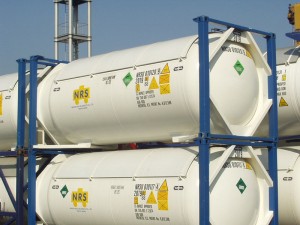Dangerous goods represent raw materials that are vital for the normal operation of our economic and social system, thanks to how they allow us to have access to a multitude of medicines to cure diseases or to supply our vehicle with the most advanced fuel, for example. These types of goods are repeatedly transported daily around the world and require special precautions to be taken. However, before going into greater depth, we are first going to look at the definition of dangerous goods.
What are they? Dangerous material refers to any substance or product that can generate or give off fumes, smoke, dust, gases or fibers capable of producing infectious, irritable, inflammable, explosive, corrosive, suffocating, toxic effects or of any other of a dangerous nature during its manufacture, handling, transport, storage or use. Any material that can generate ionizing radiation in quantities or concentrations that are likely to injure the health of persons who come into contact with it or who may cause material damages to facilities or the environment is also defined as hazardous.
For the transport of dangerous goods, it is necessary to classify the committed materials, taking into account their chemical characteristics and how dangerous they are. The United Nations Organization has established nine different classifications, which also details the requirements that their transport must comply with. The most problematic, explosive and radioactive materials (classified as 1 and 7 respectively) require express authorization by the relevant authority, which will depend on the environment where the transport is taking place.
The processes for the handling of this type of goods in Spain are subject to 1992 Legislation on the transport of dangerous goods, depending on the means of transport used for the shipment. The most difficult part of the process is the packing of the goods, where goods declared as dangerous should be the last cargo carried on the ship to minimise the time on the ship, as is the case for maritime transport operations. Each classification also has an international symbol, which must be clearly visible during transport.
Sea transport, the most in demand method
Maritime transport accounts for 80% of global freight traffic with 50% of cargo transported by sea estimated to be classified as dangerous and / or harmful to the environment.
Sea transport of committed materials is carried out in a range of formats: solid and liquid bulk, packages, parcels, pressure vessels, liquefied gases and containers. The risks associated with sea shipment are added to those involving the handling and transport of dangerous products, especially on small vessels where sea conditions cause the ship to move from side to side even more. Container transport is most common method used on this route, which accounts for 30% of all dangerous shipments that take place.
Legislation in place for the transport of dangerous or contaminating goods in the marine environment is included in the IMDG (International Maritime Dangerous Goods) code, which specifies the type of stowage, incompatibilities, segregations, etc. Thus, according to the above, the international symbol of each category must appear on all four sides of the container or the cargo should be placed on the bow side, the area furthest from the crew in container transport operations.
The transport of dangerous materials by sea always represents a difficult challenge for logistics companies, with certain shipping companies refusing to transport such goods, often due to negative experiences (either their own or third party ones).
Therefore, the only way to ensuring that all goods arrive in proper conditions is by opting for experienced companies such as Bilogistik, a specialist in freight transport services and handling of all types of goods (using any means of transport).


